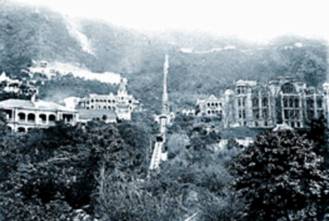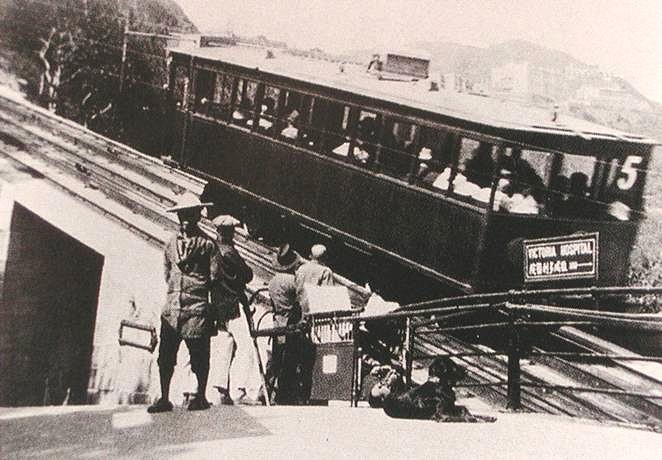T h e P e a k T r a m - H i s t o r y
More than a funicular
The Peak Tram, Hong Kong's famous funicular railway, as well as the first public transport began operation in May 1888 and has served Hong Kong successfully over the past 112 years.
Originally the Peak Tram was operated by coal fired steam boilers, this was replaced by an electrically powered system in 1926. A 62 seat, lightweight all-metal tramcar was introduced in 1956. Finally in 1989, the present tramcars commenced service carrying 120 passengers daily from 7:00am to midnight.
The Peak Tram has changed mainly from serving local commuters to become more and more associated with the role of a tourist and recreation service.
Commuters pass 4 intermediate stations between the two terminals - Barker Road, May Road, MacDonnell Road, and Kennedy Road. These stations were named after:
- The first commander of the British Forces during 1888 to 1892 - Dennis Barker,
- Barker's son-in-law, Francis Henry May - the Governor of Hong Kong during 1912 to 1916,
- Both MacDonnell and Kennedy, were governors of Hong Kong during the early 1920s.

Garden Road, lower Terminal, in 1890
During its first year of patronage, the Peak Tram carried over 150,000. However, over the years this number has increased considerably and in 1999 it rose to over 4 million commuters.
Although the surrounding scenery has changed tremendously over the years with skyscrapers sprouting from the mountain, the original track still remains. There are two ropes of a nominal diameter of 44mm with a breaking strength of 139 tonnes. The emergency rail clamp brakes on the tramcars are capable of stopping a fully loaded tramcar at the steepest part of the track. The Peak Tram, a double reversable funicular railway follows the Swiss Drive System.
It has been almost universally called simply "the Peak" ever since Hong Kong's early days when it was used as a signalling post.
The Peak, pioneering residents soon discovered, offered tremendous relief from the city's sweltering summers. The heat was intolerable in those days long before air-conditioning and refrigeration.

The track to the Peak, about 1932
Sir Richard MacDonnell, Governor of Hong Kong from 1866 to 1872, was one of the first to have a summer home constructed on the Peak around the year 1868. Wealthy residents and some of the hongs soon followed his example.
It was however quite the feat to get to and from The Peak. Grass-cutters' tracks provided the first rough routes to the Peak. Some people travelled up and down on horseback, although Hong Kong's climate did not really favour the keeping of horses. Carriages could bowl elegantly around town, but most paths were too steep and too narrow for even the smallest wheeled vehicle. Most people in those leisurely days were content to allow themselves to be carried to and from town by sedan chair, not the most comfortable mode of transport.
The Peak Hotel opened in 1873 on land acquired by Mr. Findlay Smith. An ambitious man, Mr. Findlay Smith was not satisfied with the volume of business attracted by his hotel, he felt he should encourage more people to travel up the Peak. After some major lobbying they needed a tram, he and his partner acquired the rights to the Tramway for the princely sum of HK$2000!

Barker Road Station, about 1921
It was not known how huge boilers and the other heavy equipment were hauled over such basically inhospitable terrain, but the boilers were probably assembled once they reached the engine room site. Today we can only speculate as to how they actually arrived at their destination. Transport of the 2.4-metre diameter winding drums must have been equally daunting. Laying the track itself would also have presented immense difficulties, as each piece of rail would have been approximately 7 metres long, weighing over 136kg.
On May 30, 1888 His Excellency, the Governor, and Lady des Voeux officiated at the opening of the Peak Tram.
From 1908 until 1949, the first two seats were reserved for the use of the Governor of Hong Kong and could not be occupied by anyone else until two minutes prior to departure time. A brass plaque affixed to the back read: "This seat is reserved for His Excellency, the Governor."
In 1926, there were separate sections: for First Class passengers, and soldiers and policemen (who paid two-thirds of the full fare).
The Kadoorie family's long-standing association with the Peak Tramways Company dates back to 1905, at which time the late Sir Elly Kadoorie, K.B.E., played an active role in transforming the former private company into a public limited company.

The Peak, original coal-fired
engine room, about 1888
Source: Peak Tramways Company Limited (www.thepeak.com.hk/tram/history.html).
Back to the table of contents
© Pierre Arrigo, 2001




